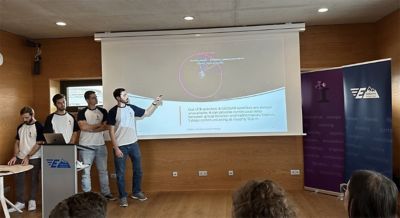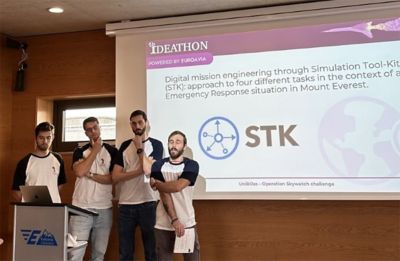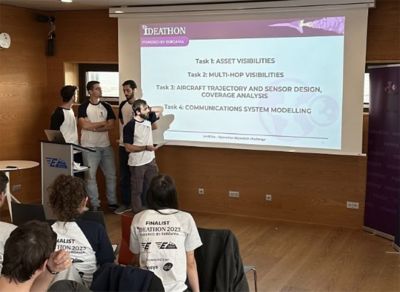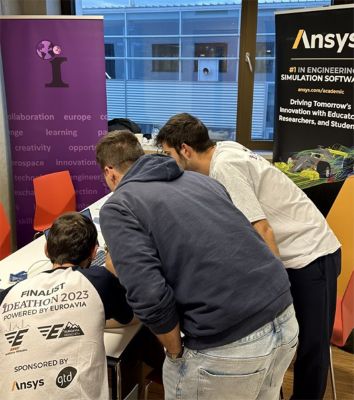-
United States -
United Kingdom -
India -
France -
Deutschland -
Italia -
日本 -
대한민국 -
中国 -
台灣
-
Ansys is committed to setting today's students up for success, by providing free simulation engineering software to students.
-
Ansys is committed to setting today's students up for success, by providing free simulation engineering software to students.
-
Ansys is committed to setting today's students up for success, by providing free simulation engineering software to students.
-
Contact Us -
Careers -
Students and Academic -
For United States and Canada
+1 844.462.6797
ANSYS BLOG
February 23, 2024
University Students Develop Mission-Ready Skills with STK
An avalanche has trapped a group of students on Mount Everest. Desperate for rescue, they are relying on other students to locate them and make sure they get off the mountain safely. Thankfully, the scenario wasn't real, but the digital mission engineering skills and tools student teams used during the Ideathon Challenge were.
Established by The European Association of Aerospace Students (EUROAVIA) and sponsored by Ansys, the Ideathon Challenge is an aerospace-related competition for European students pursuing bachelor’s or master’s degrees. The challenge aims to stimulate the scientific curiosity and potential of students by providing an opportunity to explore aerospace applications and network with other students and industry professionals. Participants must produce the best solution to challenges proposed by supporting companies.
With access to Ansys’ simulation tools through a student team partnership under the Ansys Academic Program, Ideathon 2023 participants applied Ansys Systems Tool Kit (STK) digital mission engineering software to execute a tactical emergency response effort during “Operation Skywatch.” Equipped with access to STK, students embarked on a variety of analysis and design tasks, requiring them to strategize and prioritize challenge objectives to complete a successful mission.

Students from the Alma Mater Studiorum - University of Bologna demonstrate satellite connection analysis in Ansys Systems Tool Kit (STK) during Ideathon 2023.
Apply Digital Mission Engineering to Real-life Scenarios
Digital mission engineering is commonly used in aerospace, defense, telecommunications, and other industries, playing a critical role in mission planning, analysis, and operations. In “Operation Skywatch” students utilized STK to establish a robust communication link between an airborne unit and its ground station while also deploying sensing instruments for surveillance and reconnaissance over a designated disaster area.
The scenario was not for the faint of heart. The fictitious challenge was based upon an avalanche at Mount Everest which left last year’s Ideathon participants trapped. Every year, approximately 800 people attempt to climb Mount Everest, which resides in a hotspot of intense tectonic activity in Nepal’s Sagarmatha National Park. Consequently, the region is no stranger to earthquakes and subsequent avalanches.

Students explain how they applied STK to complete an emergency response effort with success.
Unfortunately — in the fabricated scenario — participants from last year’s competition ignored warnings from the Lukla Meteorological Agency and embarked on a quest to conquer Everest’s peak. As a result, they were trapped by an avalanche and their rescue depended on the skills of this year’s participants, emphasizing the significance of digital mission engineering in real life scenarios.
Students were given four main tasks to complete using STK. Some tasks had definitive solutions, while others were exploratory, encouraging students to strategize unique design and mission approaches to achieve success. Each task stood independently, enabling students to navigate through them without mandatory sequential completion. This gave students the autonomy to strategize and prioritize challenge objectives while aligning with the distinctive strengths and limitations of their team’s expertise.
Gear Up for the Task
STK is a valuable tool for aerospace applications with its ability to model complex systems inside a realistic and time-dynamic 3D environment, including radars, radio frequency (RF), and electro-optical and infrared (EOIR) sensors.
Tasks were classified into the following four categories:
- Asset visibilities
- Multi-hop visibilities (ability to “hop” back and forth between two or more network servers)
- Aircraft trajectory and sensor design; coverage analysis
- Communications system modeling

Students completed four tasks, strategizing unique design and mission approaches to achieve success.
In the first task, students had to determine if the personal locator beacons (PLBs) worn by the mountain climbers had sufficient GPS reception to detect the location of the group. PLBs primarily communicate with satellites that are part of the Cospas-Sarsat system, an international satellite system designed for search and rescue. PLBs transmit distress signals that are received by a network of satellites in geostationary orbit (GEO), low Earth orbit (LEO), and medium Earth orbit (MEO).
Assuming that the PLB had sufficient GPS reception, the second task challenged students to determine if the PLB signal could be relayed from the group’s location to the command center via the Cospas-Sarsat constellation.
For the third task, students worked under the pretext that the command center received the distress ping, and an unmanned aerial system (UAS) was deployed to the area to locate the group. As part of this task, students analyzed and designed the trajectory of the UAS, which was equipped with a thermal imaging sensor to survey as much of the area as possible.
In the fourth and final task, the rescue helicopter has located the group and is transporting them back to the command center for medical treatment. However — while in flight — the pilot needs to inform the center of the group members’ health statuses to ensure appropriate medical care is available immediately upon landing. To complete this challenge, students analyzed various frequency bands and modeled a receiver and transmitter to establish the most optimal two-way communication link.

Finalists apply Ansys STK to analyze sensor coverage for a search and rescure mission.
Acquire Industry-Ready Skills
By learning digital mission engineering skills as students, aspiring aerospace professionals gain an industry edge and better understanding of how to apply the tools in real-life scenarios. Building upon conventional simulation platforms, digital mission engineering eliminates the need for multiple tools to assess diverse scenarios. Using STK, students can investigate numerous scenarios, each with distinct variables, within a single environment.
“From our experience, digital mission engineering is still an underexplored tool in academic education and early-career skill portfolios,” says Leo Buchner, president of the International Board of EUROAVIA. “We assess it as very impactful.”
Ideathon teams are arranged according to the participants’ nearest city and the closest EUROAVIA local chapter. The 2023 Ideathon first place winners were EUROAVIA Forlì-Bologna, Italy, with team members from the Alma Mater Studiorum - University of Bologna in Italy. Second place went to the EUROAVIA Bucharest, Romania chapter, with team members from the Politehnica University of Bucharest in Romania.
The recent competition comprised two phases, as follows, with supporting online activities, including optional webinars.
- Phase One (September 3-7, 2023) in Terrassa, Spain: Five teams — totaling 23 participants — solved challenges set by organizers and two finalist teams were announced on the last day.
- Phase Two (November 5-9, 2023) in Munich, Germany: The two remaining teams — totaling eight participants — completed new challenges to compete for first place.
Finalists integrated STK during the second phase of competition, which made a notable impact on mission success.
“Without STK, the challenge as it was formulated would not have been possible,” says Buchner. “The difference in the quality of the challenge was worlds. The team was able to use the results from the local stage and elevate those results to something not feasible without the software.”


Ideathon 2023 participants had access to STK through a student team partnership under the Ansys Academic Program.
Prepare for Takeoff
Ansys is dedicated to ensuring the affordability and accessibility of simulation tools and promoting science, technology, engineering, and math (STEM) education to equip tomorrow’s engineers.
To learn how Ansys can support your team, browse the Ansys Student Team Partnerships Guide and request a partnership.











